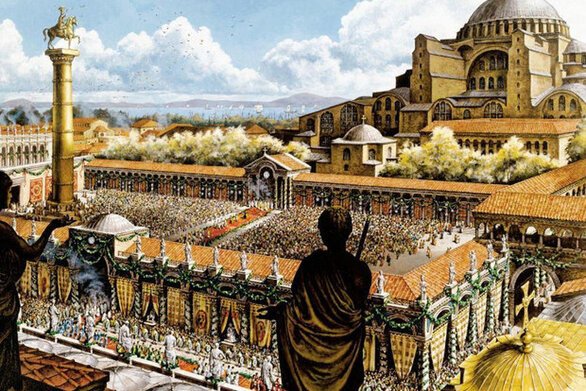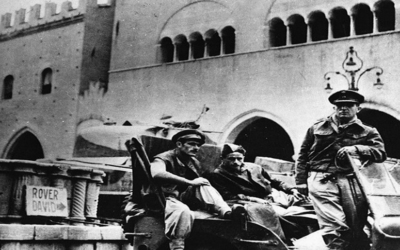HISTORY
HISTORY

The Byzantine Empire was established with the inauguration of Constantinople on May 11, 330 and lasted until its final fall, the Fall of Constantinople on May 29, 1453.
The “Christianized Roman state of the East” derived from the Roman Empire. Its central aim was the re-establishment of the empire. During the dynasty of Heraklion it was transformed into the “Hellenized empire of the Christian East” and finally, mainly from 1204 onwards, with the occupation of Constantinople by the Venetian fleet and the Latin Crusaders, the “Greek Byzantine-Roman Empire” was born. However, the term Greeks was used to refer to Byzantium as early as the years of King Otto I.
The Eastern Roman Empire is a peculiar historical phenomenon: Constantine is recognized as the first emperor of the Eastern Roman Empire without being the last Roman emperor, while the Eastern Roman Empire is the only empire that was not built on the ruins of another as a result of military success. Rather, it was the result of developments in the Roman world.
This is a new phase of Roman history that took shape under the dominant influence of Greek culture and traditions and the Greek language, with the relocation of the political center of the state to the Hellenized East, the Christian faith and the Roman political theory.
The official name of the new capital, by decision of its founder, was “New Rome”. But everyone called it Istanbul and later just “City”. Its position was remarkable. It is where the roads that connected Europe with Asia, but also the Black Sea with the Aegean and the Mediterranean meet. The Egnatia Highway stretches up to here, while this is where the trade routes to Asia Minor and the provinces of the East are located.
Constantinople was shaped similarly to Rome. A main street, the Middle Street, connected the palace with the Golden Gate. A circular square with a statue of Constantine placed on a pillar was built on this road. Other public buildings were located in this square. Later, Theodosius I and Arcadius created similar squares with their own statues.
The history of Byzantium is divided into the “Early Byzantine period (4th century-6th century)”, the “Middle Byzantine period” and the “Late Byzantine period”.
With the Fall came the final overthrow of the empire. However, the spiritual tradition of Byzantium remained remarkable, as many scholars settled in the possessions of the Venetians in Crete and the Peloponnese, but also in the countries of Europe themselves and passed on Greek education to the West.
Also read: April 29, 1091 | The Byzantine Emperor Alexios I obliterares the Pechenegs
With information from: System of Digital Interactive Education and Promotion Services for Byzantine Culture
Memorial Speech by the Minister of Defence Vassilis Palmas at the annual memorial service for the fallen of the 3rd Company of the 211th Infantry Battalion
The Minister of Defence of the Republic of Cyprus, Mr. Vassilis Palmas, attended the annual commemoration of the fallen of the 3rd…
120 years since the death of Pavlos Melas—The Hero of the Macedonian Struggle—Photos
The Armed Forces honor the memory of the ethnic martyr who gave his life for the liberation of Macedonia…
80 years since the Battle of Rimini – The Brigade that wrote golden pages of history
The “Rimini Brigade” wrote new pages of history for Greece, placing it in the camp of the winners. This success was linked to hope and…
FLANQ | AI-Powered Autonomous Maritime Solutions in Favour of European Security
In response to Europe’s growing security challenges in the maritime domain, FLANQ has launched as a new…
CERIDES | 1st Planning Conference of the UCPM DEMONAX – Cyprus Earthquake Full-Scale Exercise
CERIDES – Centre of Excellence in Risk and Decision Sciences of European University Cyprus had a strong presence during the 1st Planning…
EMAK | New Operational Boost with Eight INTRUDER SE Drones
The Ministry of Climate Crisis and Civil Protection is moving forward with the procurement of eight INTRUDER SE-type unmanned aerial…
KNDS France – METLEN | Partnership for the Production of the VBCI PHILOCTETES® in Greece
METLEN has entered into an exclusive partnership with KNDS France for the production of the latest-generation French 8×8 Infantry Fighting…
USΑ | Bipartisan Bill Submitted to US Congress to Lift Cyprus Arms Embargo
A bipartisan bill titled the “American-Hellenic-Israeli Eastern Mediterranean Counterterrorism and Maritime Security Partnership Act of 2025”…
AI Task Force | First Session of the National Committee for Artificial Intelligence of Cyprus
The first session of the National Commission for Artificial Intelligence (AI Task Force) was held, marking the official start of the work…















0 Comments